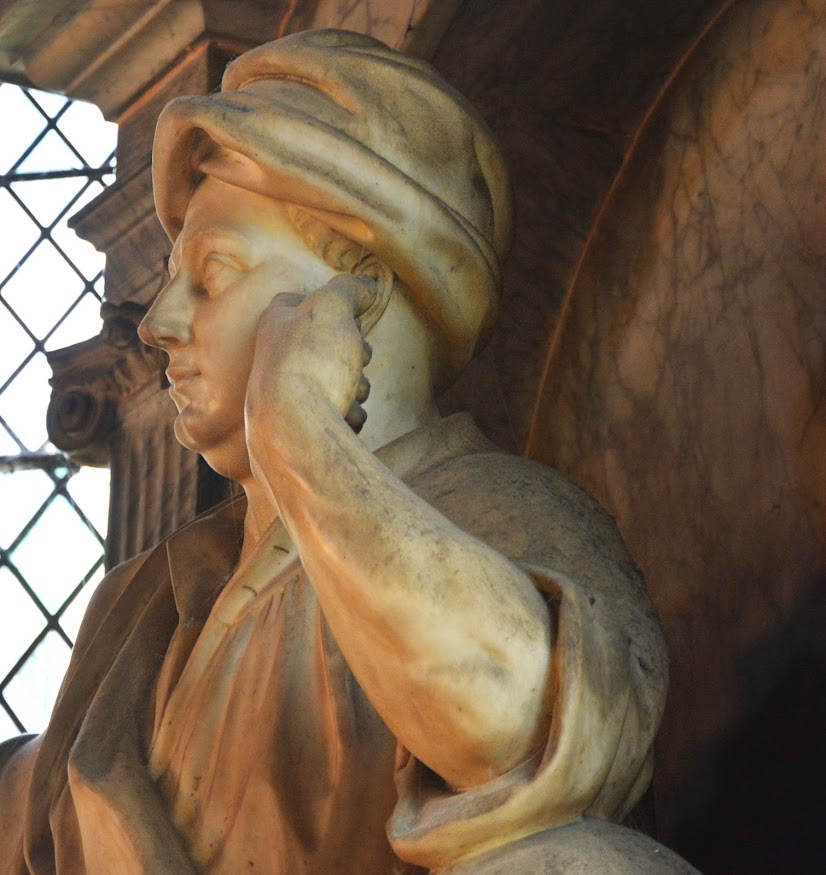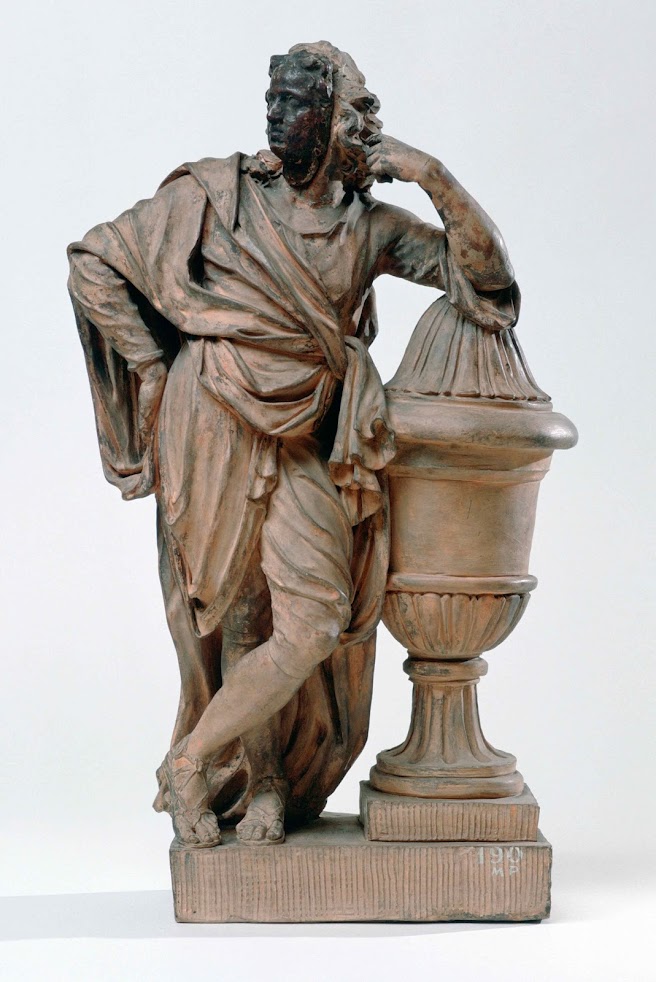A series of notes and images.
The Monument was erected on the instructions of his wife Ann Davies nee Brockholes, probably c. 1728/29, making it one of the earliest monuments designed and built by Henry Cheere.
After his apprenticeship with Robert Hartshorne, Henry Cheere set up independently in St Margaret's Lane, Westminster in 1728 but worked in collaboration with Henry Scheemakers until 1733 when Scheemakers left England in 1733.
The pose here of the standing cross legged figure leaning against an urn is that first used by the Italian Guelfi (working in England c1718 - 1734) on the influential monument in Westminster Abbey to James Craggs Secretary of State, put up c 1722 - designed by James Gibbs and superintended by Alexander Pope.
The pose of the Guelfi Craggs statue was very influential on future monuments - the Westminster Abbey monument to Shakespeare by Scheemakers of 1740 being the prime example.
It was used on the monument of 1746 to William and Elizabeth Powlett at St George's Church West Grinstead by Rysbrack,.
The statue of George Cooke of about 1749 formerly in the gardens of Belhamonds House, Middlesex and now in the Ashmolean.
The 1757 monument to Charles Polhill, St Bartholomew, Otford, Kent by Henry Cheere.
The 1761 to Cholmley Turner, at St Cuthberts, Kirkleatham, Cleveland also by Henry Cheere.
The monument to Peregrine Bertie at Edenham by Henry Cheere of c 1741/42.
The monument to Sir John Dutton at Sherborne, Glouc. by Rysbrack of 1749.
Duke odf Somerset in the Senate House, Cambridge Rysbrack of 1756.
For more on Guelfi and the derivation and use of this pose see -
https://bathartandarchitecture.blogspot.com/2015/08/notes-on-giovanni-battista-guelfi-16912.html
https://bathartandarchitecture.blogspot.com/2016/01/the-rysbrack-statuettes-of-rubens-van_8.html
Robert Davies of Llanerch.
Robert Davies (1685/86 – 22 May 1728) was a Welsh antiquary and son of fellow antiquary, Robert Davies of Llanerch (d. 1710).
Davies was born on 1685/6 the son of Robert Davies and his wife, Letitia (née Vaughan). Davies matriculated from Brasenose College, Oxford University on 27 June 1702, aged 16. His father died on 8 July 1710, when his Llannerch and Gwysaney estates passed on to his son. The son of our Robert Davies another Robert became High Sheriff of Flintshire in 1744.
See - Usher, G. A. (1964). Gwysaney and Owston: A History of the Family of Davies-Cooke of Gwysaney, Flintshire and Owston, West Riding of Yorkshire.
The current church was erected c.1500 under the patronage of Margaret, Countess of Richmond and Derby, on the site of an Early Medieval church. It is one of the 'Stanley' series of churches which were rebuilt around this time.
Later additions include the West Tower built 1768-73 which is attributed to Joseph Turner of Chester, and the Apsidal Chancel/general restoration of the church which was undertaken by G. G. Scott in 1856. The Church continues in use as a place of worship by the Church in Wales.
__________________
The Wynn's of Tower (or Twr Broncoed), Nercwys,
The Monuments in St Mary's Church, Mold.
The Monument to John Wynne of Tower,
died 1737
Erected by his son William Wynne.
William Wynne d. 1776.
William Wynn instructed that the monument be carved in his lifetime.
The monument inscribed by Michael Rysbrack(1694 - 1770).
Notable for the very fire carving of the Cherub's heads.
St Mary's Church, Mold, Flintshire.
.......................
of tangential interest.
A Photograph of Tower (or Twr Broncoed) taken on 7th January 1856.
The image below from.
https://britishphotohistory.ning.com/profiles/blogs/unidentified-1856-british-photograph
It remains substantially unchanged.
The house (Listed Grade 1) is now a guest house and wedding venue.
see - https://tower.wales/contact-us/
The earliest part of the building, fortified tower house, is believed to date back to circa 1440-50. This
originally adjoined an open hall and the building has seen many structural changes over the centuries. A story perhaps apocryphal, of the Tower is the hanging of the former mayor of Chester in the 15th century. It is alleged that this man met his end in a kitchen in the house.
................................
Again of tangential interest ref. St Mary's, Mold -
https://www.walesher1974.org/herumd.php?group=CPAT&level=3&docid=301447635




















No comments:
Post a Comment